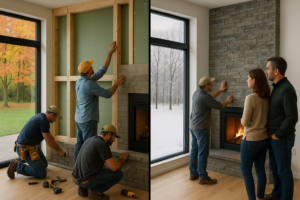Choosing the right contractor can make or break your home remodel—it’s the difference between a dream space and a disaster zone. A good contractor turns your vision into a finished reality, on time and on budget. A bad one leaves you with shoddy work, blown timelines, and depleted finances. Contractor horror stories aren’t rare: vanishing $10,000 deposits, half-finished kitchens, or jobs that drag on for months. But these disasters are preventable. This guide arms you with clear steps to help you hire a contractor who delivers—not one who disappears.
Why Hiring the Right Contractor Matters
Your contractor is more than a tradesperson. They are your remodel’s project manager, logistics coordinator, and quality control officer. A reliable contractor manages permits, coordinates subcontractors, ensures code compliance, and delivers workmanship that holds up. A poor one causes delays, blows budgets, and leaves you chasing repairs. According to Houzz, 53% of remodeling projects exceed budgets, and Clever Real Estate reports 46% suffer serious delays. The common factor? Inadequate contractor selection.
A reputable contractor gets your $25,000 kitchen completed in eight weeks with durable materials, licensed subs, and no shortcuts. A fly-by-night operator turns that same kitchen into a $35,000 quagmire. Protecting your money and home starts with choosing well.
Where to Find Qualified Contractors
• Personal Referrals: Ask friends, family, and neighbors who they used and whether they’d hire them again. Real-life experience beats online hype.
• Online Searches: Google ‘remodeling contractor [your city]’ and check reviews. Focus on patterns, not star ratings alone.
• Trade Associations: Use directories from NAHB, NARI, or Angi. These platforms often vet professionals and require membership standards.
• Local Suppliers: Ask staff at hardware stores or lumberyards who consistently buys quality materials and pays on time.
• Home Shows: Local remodeling expos offer face-to-face interaction with contractors and showcase their work.
Narrow your list to three to five contractors. Too few, and you lack comparison. Too many, and the process becomes overwhelming.
Key Credentials to Verify
• License and Insurance: Always check state license status through your contractor licensing board. Confirm liability insurance (at least $1 million) and active workers’ comp.
• Experience: Look for contractors with at least five years of experience in projects similar to yours. Ask for photos and addresses of completed work.
• References: Call three recent clients. Ask about timelines, budget accuracy, communication, and any issues that arose.
• Portfolio: Review completed jobs—in person if possible. Look for quality finishes and attention to detail.
• Certifications: NARI, NKBA, or manufacturer certifications reflect professionalism and training.
Vetting the Contractor Thoroughly
• Interview Them: Ask about your project timeline, who will supervise the job, and whether they pull permits.
• Check Online Reviews: Visit Google, Yelp, and the Better Business Bureau.
• Visit a Job Site: If they’re working locally, ask to drop by. A tidy site signals professionalism.
• Verify Insurance Directly: Call their insurance carrier to ensure coverage is current.
• Run a Background Check: Over 1/3 of those working in construction have a criminal background. Use TRA’s background check tool at Trusted Remodel Advisor.
Getting and Comparing Bids
• Provide Detailed Specs: Outline the size of the space, types of materials, and expected features.
Affordably create your own pro-grade specs with Trusted Remodel Advisor DIT Kit.
• Demand Line Items: Ask for costs broken into labor, materials, permits, and overhead.
• Compare Apples to Apples: Ensure each bid covers identical work.
• Be Wary of Lowball Bids: These often skip essentials like permits or qualified subs.
Locking In the Right Contractor
• Detailed Scope of Work: Itemize all tasks and materials.
• Timeline and Milestones: Include start and end dates, with milestone check-ins and penalties for delays.
• Payment Terms: Start with 10% down. Schedule remaining payments by project phase.
• Change Orders: Require written, priced, and signed change orders before proceeding.
• Warranties: Minimum one year on labor and materials.
Red Flags That Spell Trouble
• No license or insurance
• Vague bids
• Demands for 50% or more upfront
• Pressure tactics or ‘sign now’ ultimatums
• References who hesitate to talk
Final Thoughts: Own the Process
Hiring a remodeling contractor isn’t just a task—it’s a high-stakes decision. You’re not just paying for labor and materials; you’re entrusting someone with your home, your budget, and your peace of mind. Take control: vet, verify, and insist on a detailed contract. The contractor you hire will shape your remodel’s outcome. Choose wisely, and your project will end not with frustration, but with pride.








